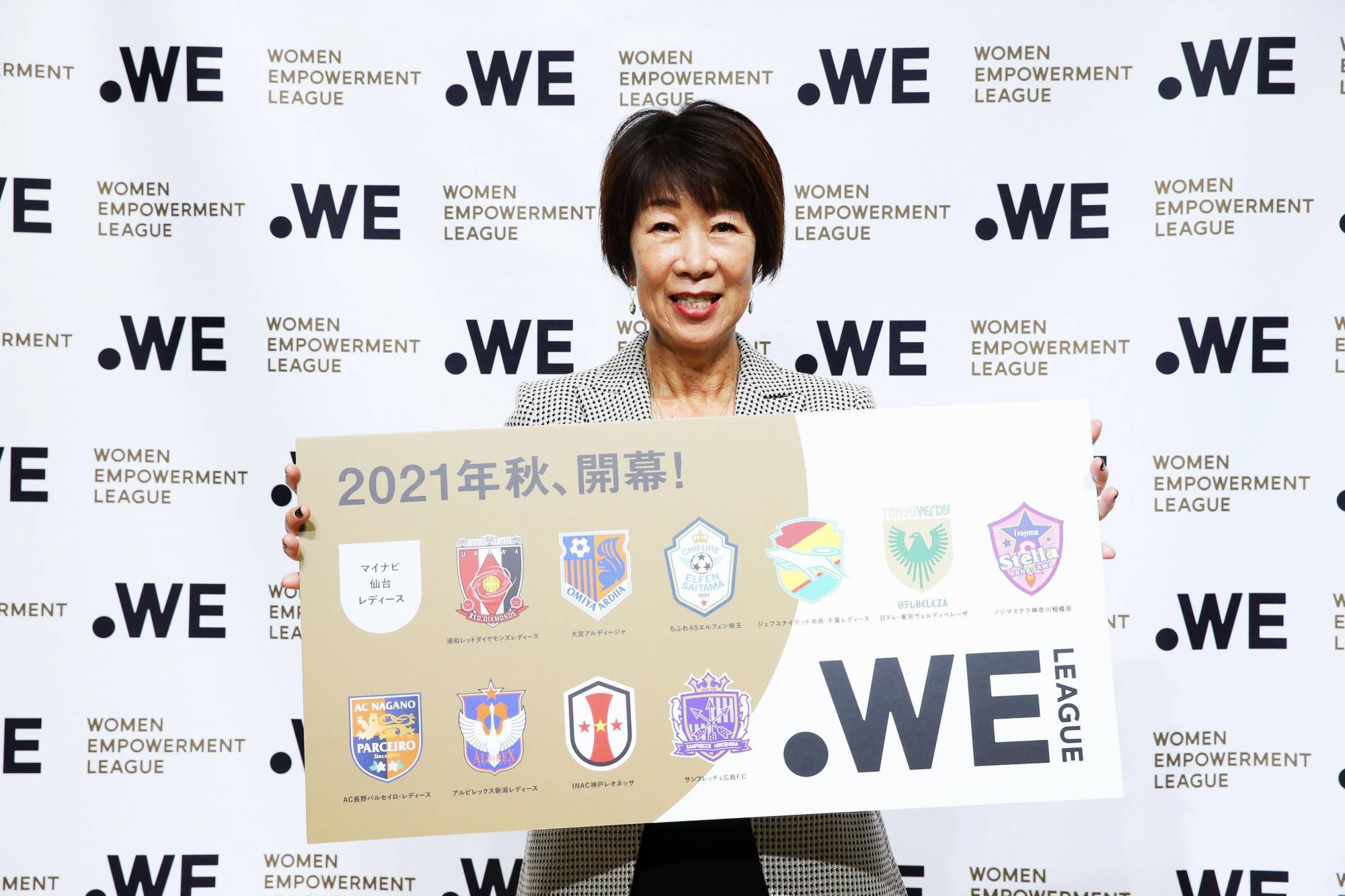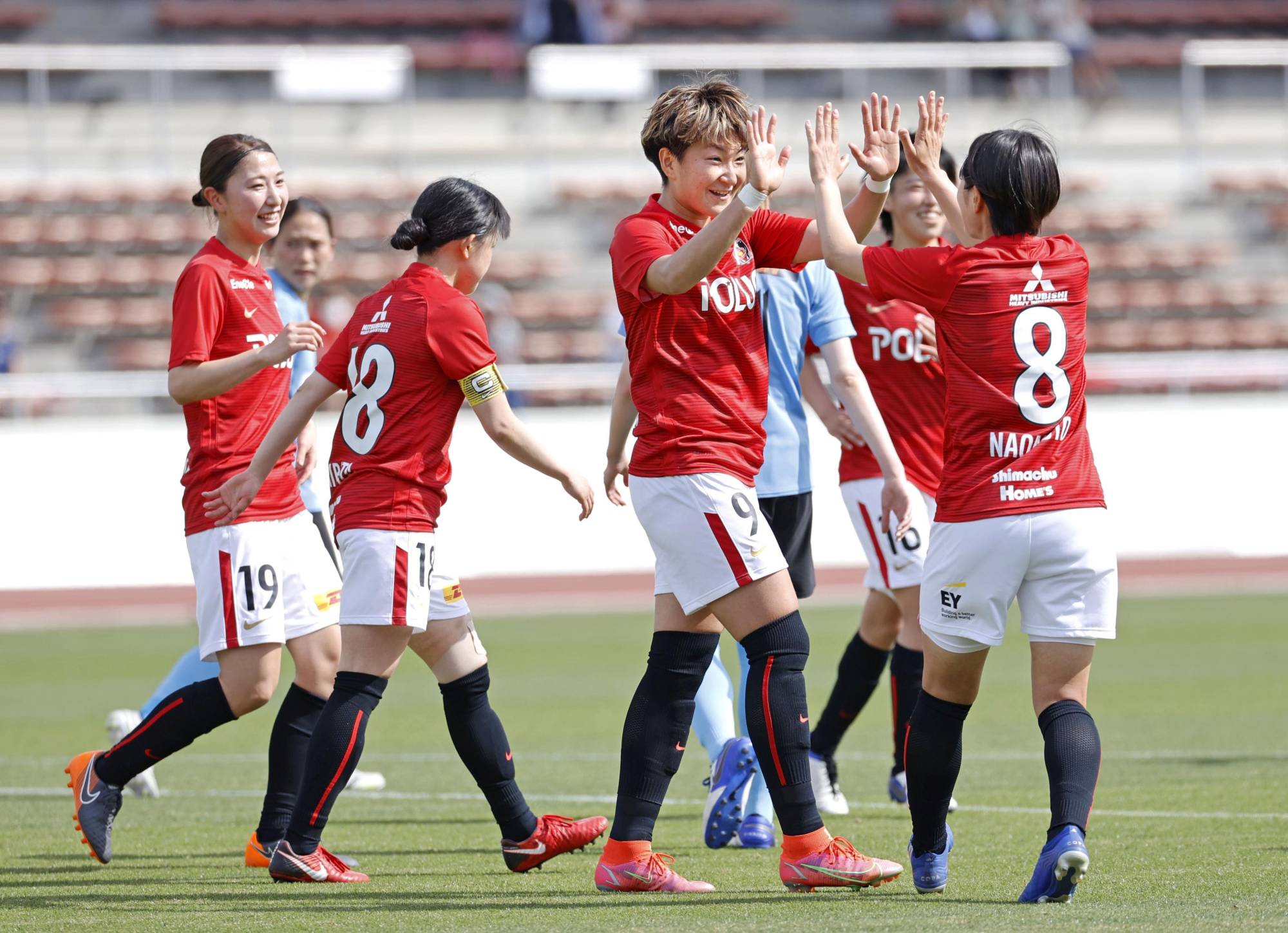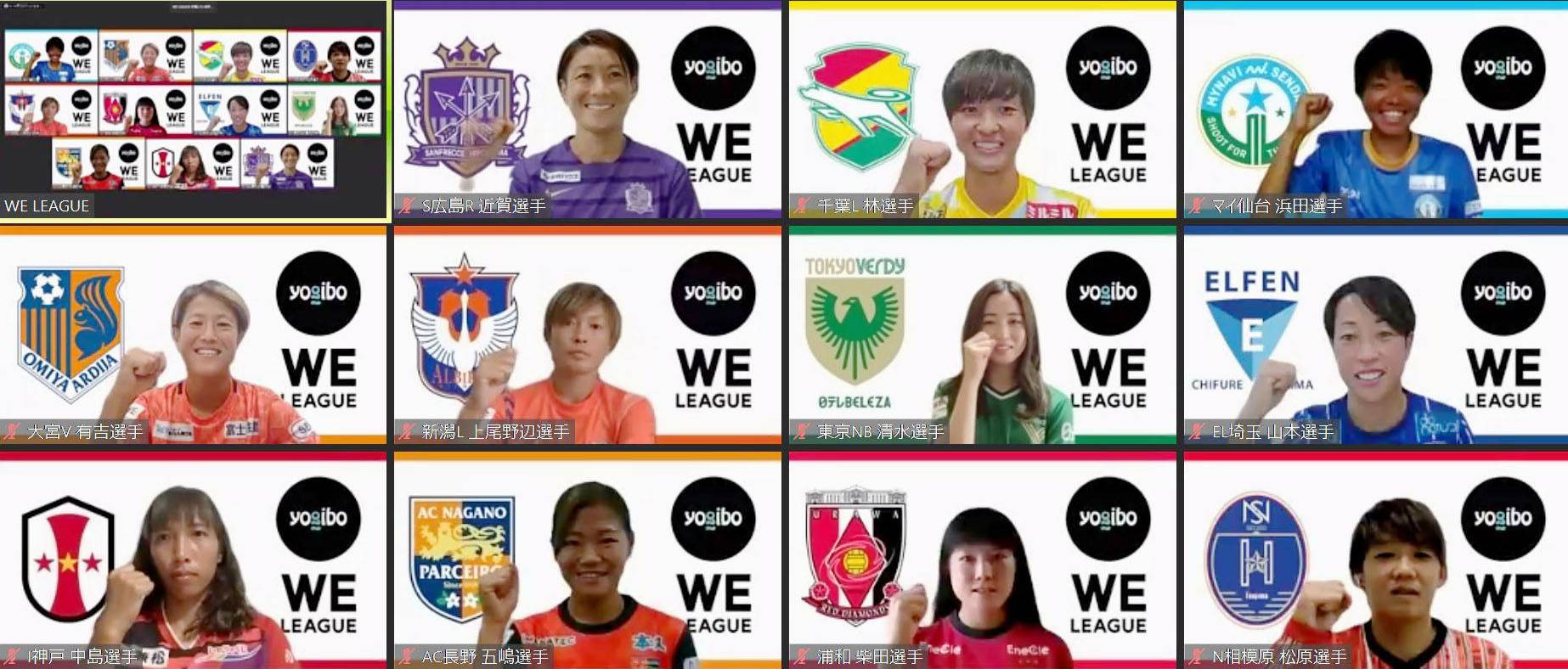In a video shown at the end of Monday’s news conference promoting the WE League’s inaugural season, Chairperson Kikuko Okajima and a trio of players with international pedigree kick a ball through glass plates representing barriers facing female players in Japan, with the broken shards set to be repurposed into the league’s championship trophy.
On the nose? Perhaps. But with a name that stands for “Women’s Empowerment,” Japan’s first professional women’s soccer league isn’t subtle about its intent to revolutionize the sport.
“Three years since it was first conceptualized, the WE League now exists thanks to the efforts of everyone who wants to see women’s soccer grow,” Okajima said. “We want to succeed and improve the position of not only women’s soccer, but women’s sports as a whole in Japan.”
The league’s targets both on and off the pitch may be ambitious, but they are certainly welcome. Over 30 years have elapsed since the founding of the L. League — Japan’s first national women’s competition — but successive iterations have remained semi-professional at most, with corporate team owners supporting most players by hiring them as company employees and only a handful of stars earning professional contracts.
“This honestly feels like a new start for women’s soccer,” INAC Kobe Leonessa defender Miyabi Moriya told Radio Kansai. “Until now, only players at INAC have been able to focus on soccer, but it’s a big step to have that become true for every team.
“Now that young girls can dream of becoming pro soccer players, we have a responsibility to turn our matches into even bigger events.”
While the pandemic will keep initial crowds smaller than officials would have preferred, the league remains committed to attracting younger fans, women and families — demographics that were relatively under-represented in the Nadeshiko League.
Helping to accomplish that is a diverse array of corporate partners, including furniture manufacturer and title sponsor Yogibo — which has pledged to help clubs create sensory rooms for fans with light and sound sensitivities — and streetwear brand X-Girl, which is outfitting seven of the league’s 11 teams.
Among those wearing those uniforms will be foreign players that the league hopes will help domestic players further develop their skills and prepare for the kinds of opposition they’ll face in international tournaments.
Both the WE League and the Japan Football Association have offered clubs financial aid for signing foreign players. The JFA is helping teams foot the bill for players from Southeast Asia — a move that mirrors the J. League’s efforts in the region — while the WE League’s money covers signings from countries at the top of the FIFA world rankings.
“I think bringing that experience and professionalism into this environment will help,” Australian midfielder Alex Chidiac said when asked what she hopes to bring to JEF United Chiba. “It will help me as well, to be able to adapt not only to the football but to life here too.
“I’ve always admired how the Japanese played football. We (Australia) played against Japan and they always beat us. They’re very skillful and I’ll improve a lot by being here.”
Officials hope those circumstances will allow teams to develop stronger players capable of contributing to a revitalization of Nadeshiko Japan, which has struggled to return to the peaks it attained in 2011 when Homare Sawa and company won the Women’s World Cup in Germany.
While Japan did go on to win silver at the 2012 London Olympics and reach another World Cup final in 2015, the women’s soccer landscape has irrefutably changed over the last decade, with the Americas and Europe in particular investing heavily in their clubs and leagues.
The new balance of power has left Japan unable to advance deep into major tournaments as easily as it once did — head coach Asako Takakura’s sides exited the 2019 World Cup and the 2020 Tokyo Olympics in the round of 16 and quarterfinals, respectively.
“I think that rather than Japan’s level dropping, it’s a case of other countries’ levels rising,” Okajima said. “In Europe, the level of play is rising in countries whose leagues have professionalized. At the 2019 World Cup, all of the quarterfinalists other than the United States were European, and it’s clear that professionalization has helped competitiveness.”

The WE League’s biggest impact may come in the form of its social activism as it seeks to promote greater roles for women in a country that has often relegated them to the sidelines. Clubs will eventually be required to maintain gender parity among their staffers and have at least one female executive. Players will be encouraged to study for their coaching badges, in the hope that after their time as WE Leaguers they will be able to help raise new generations to come.
While the coronavirus pandemic means that the WE League won’t get the same level of fanfare that the J. League did when it launched in 1993, it will be able to rely on that league’s cooperation and support. Four of the seven J. League clubs with WE League teams also participated in the founding of Japan’s professional men’s league, which is now considered the best in Asia.
“We want to give the WE League as much support as we can,” J. League Chairman Mitsuru Murai said. “In a sense our fates are shared.
“Increasing the number of female soccer fans is a matter of great importance for the J. League’s development, and because of that we want to assist the WE League with its competitions, marketing and community relations.”
There is perhaps no greater representation of how far the WE League will divert from “business as usual” than Okajima herself, who left the financial sector after 30 years to become the league’s first chairperson.
The 63-year-old — who was among the first generation of players to represent Japan — has kept her home in Baltimore and will primarily work from the United States, an arrangement made possible once the JFA realized that untethering from conference rooms could open a world of possibilities during the pandemic.
“I was happy playing in Japan and then I started to be really active and successful in the business world, and I’ve come back from the U.S. to lead this,” Okajima told The Japan Times in July 2020.
“We’re trying to imagine a different era.”



The Clubs
Teams will face each other home and away in a single-stage, 22-round season. Each team will receive two bye weeks, during which they will conduct activities promoting the principles and ideals of the WE League.
The season will be divided by a winter break lasting from early December through late February, in deference to the number of clubs in regions with severe winter weather. The campaign is expected to conclude on the weekend of May 21-22.
MyNavi Sendai — The Yurtec Stadium residents will be spending their first season under MyNavi, which purchased the team from the J. League’s Vegalta Sendai over the winter. Manager Takeo Matsuda has experience with a number of women’s clubs, having won the Nadeshiko League four times with Tokyo Verdy Beleza between 2005 and 2008. The team was originally formed at the end of 2011 as a new home for players from TEPCO Mareeze, which was shut down after the 3/11 disaster.
Mitsubishi Heavy Industries Urawa Reds — The reigning Nadeshiko League champion boasts one of the country’s best academy setups, with 13 players hailing from the youth team and an additional four concurrently registered with the junior youth squad. Urawa sent four players to the Tokyo Olympics, including veteran striker Yuika Sugasawa and defender Moeka Minami. The team’s home stadium, Komaba Stadium, was featured in the recent anime adaptation of soccer manga “Farewell, My Dear Cramer.”
Omiya Ardija Ventus — The J. League club absorbed former Nadeshiko League second-division side FC Jumonji Ventus in order to build its women’s team, bringing in a number of former national team players, including defenders Aya Sameshima and captain Saori Ariyoshi. Norio Sasaki, who led Japan to the 2011 Women’s World Cup title, is overseeing the team as its general manager.
Chifure AS Elfen Saitama — Formed in 1991, Elfen has a long-standing reputation as one of the Japanese women’s game’s most dedicated grassroots organizations. Based west of the Arakawa River that splits Saitama Prefecture, the club is operated by Chifure Cosmetics, which first became involved with the team as a naming rights sponsor in 2016. Elfen’s biggest preseason signings have been former Nadeshiko Japan midfielder Emi Yamamoto as well as Filipino striker Sarina Bolden.
JEF United Ichihara Chiba — A Nadeshiko League mainstay whose lone major title came in the form of the 2017 League Cup, JEF has moved quickly to bring international experience to its squad. In addition to Australia midfielder Alex Chidiac and Philippines striker Quinley Quezada, the team signed Taiwan goalkeeper Cheng Ssu-yu from Okayama Yunogo Belle as well as Japanese midfielders Kirara Fujio and Natsuki Kishiawa, who have recently plied their trades in Brazil and Germany.
NTV Tokyo Verdy Beleza — One of the founding members of the original L. League in 1989, Beleza is by far the most storied women’s soccer team in Japan — with far more success than Tokyo Verdy’s men’s team, which has languished in the second division for over a decade. Beleza’s trophy case includes 17 first-division titles, 15 Empress’s Cups and seven league cups to its name as well as stars like returning legend Rumi Utsugi and striker Jun Endo.
Nojima Stella Kanagawa Sagamihara — Founded in 2012 by electronics retailer Nojima, Sagamihara rose from the Kanagawa Prefecture third division to the Nadeshiko League top flight in just five seasons. After a frustrating preseason in which the team allowed 13 goals but scored just one, the team signed a pair of overseas strikers in German Cindy Koenig and former Nigeria international Uchechi Sunday. With both players needing time to integrate into the squad after competing their quarantines, manager Makoto Kitano may have to rely on veteran defender Minami Ishida and midfield captain Arisa Matsubara to hold the fort in the short term.
AC Nagano Parceiro — One of the top destinations for traveling fans this season will be Nagano U Stadium, which opened in 2015 and is the league’s top soccer-specific facility. There they’ll see a promising Parceiro squad including returnee Shino Kunisawa, who spent six seasons in Nagano before going to Italy’s first-division Serie A in 2019. The team’s history began in 2003 under private school group Ohara Gakuen, which transfered the club to Parceiro in 2009.
Albirex Niigata — One of the few clubs other than INAC, Urawa or Beleza to regularly contribute players to the national team, Albirex has been a first-division mainstay since 2007, finishing runner-up in four Empress’s Cup finals since then. While the team shares its name and badge with its J. League “brothers,” the women’s team split into its own company at the end of 2018 in order to better support its community activities in the region. Among venues the team will play at this season is Denka Big Swan Stadium, one of Japan’s venues for the 2002 FIFA World Cup.
INAC Kobe Leonessa — Japan’s most successful independent women’s team, INAC cruised to three straight Nadeshiko League titles between 2011 and 2013 — a period in which it boasted many of the national team’s top stars. Kobe last finished below third place in 2014 but has not lifted a trophy since the 2016 Empress’s Cup. The team has made up for a number of offseason departures — including new Arsenal signing Mana Iwabuchi — with several signings, including Japan goalkeeper Ayaka Yamashida and Singapore defender Rosnani Azman.
Sanfrecce Hiroshima Regina — Rather than take over a local club such as Angeviolet Hiroshima, the three-time J. League champion decided to start from scratch with its women’s team — making it the only WE League participant with no prior legacy or competitive history. Overseas viewers will likely recognize 37-year-old captain Yukari Kinga, the former Nadeshiko Japan mainstay with 100 senior caps and playing experience in England, Australia and China.
Where to watch
WE League games will be shown domestically on streaming service DAZN, with select fixtures available both domestically and internationally on DAZN’s YouTube channel.
In late August, the league established English-language Twitter and Instagram accounts.



In a time of both misinformation and too much information, quality journalism is more crucial than ever.
By subscribing, you can help us get the story right.
SUBSCRIBE NOW


